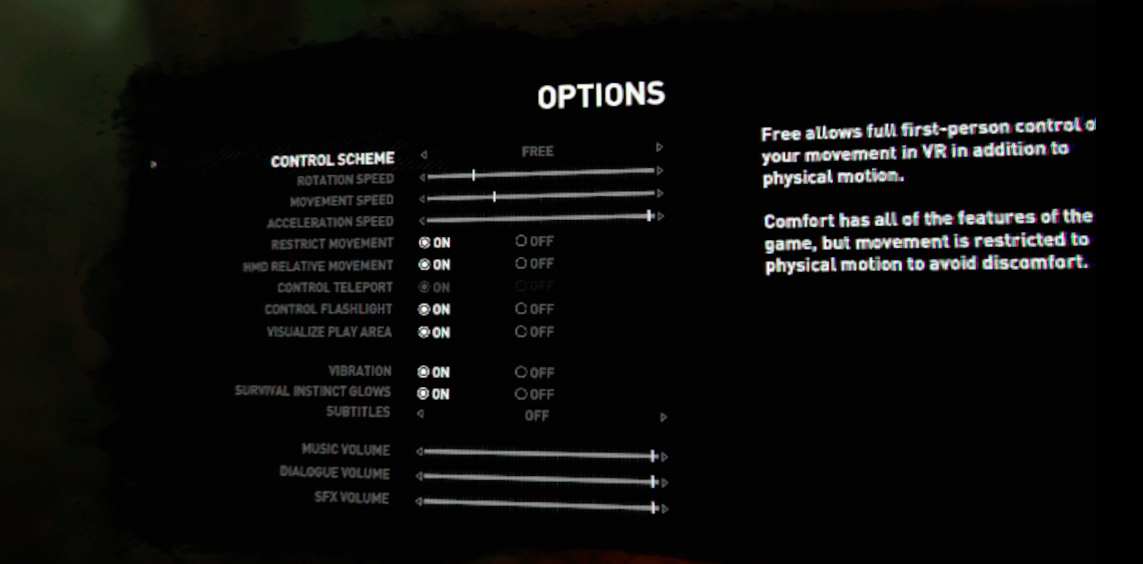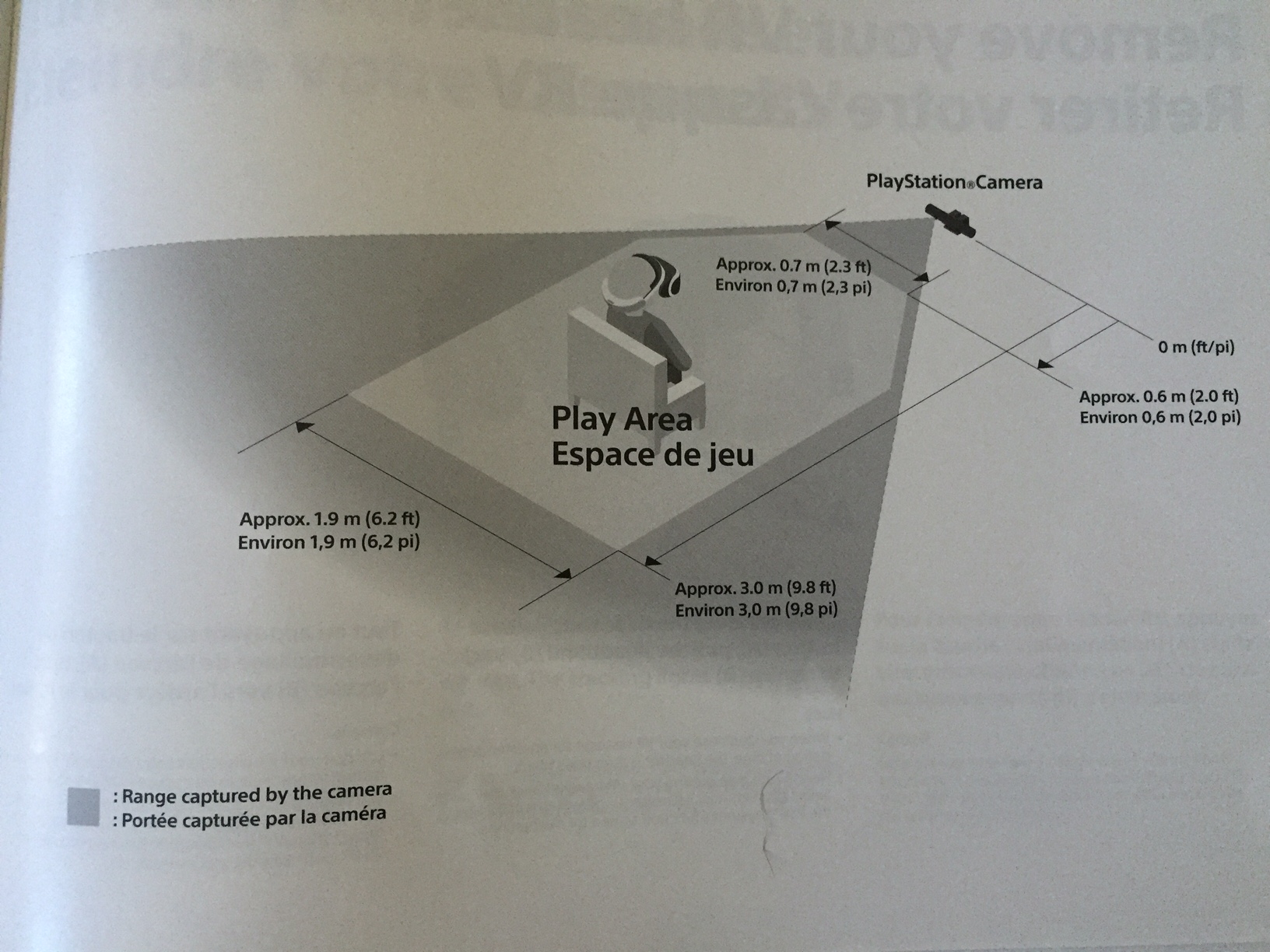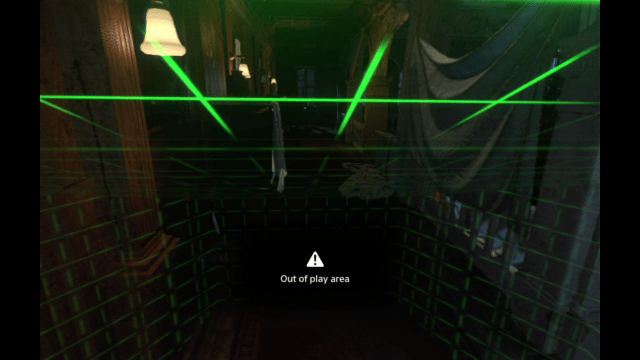A surprise feature buried in the new PlayStation 4 version of Rise of the Tomb Raider appears to show just how much of your real-life playing area can be tracked by Sony’s new PS VR set-up.
An option called “Visualise Play Area” makes the game’s VR-compatible Blood Ties expansion display green grid lines if the player moves their head or body too far out of the proper playing area. It is presumably showing the limits of what the PlayStation camera — which is mounted in front of a PSVR player and which tracks the PSVR headset and the player’s controllers — can reliably track.

You can see a short clip of me testing the visible range below. In the clip, I’m standing and playing the game in my living room at home. I walk laterally along the width of my couch to find the outer border of what the PSVR set-up can track and look back at the space. Notice that the trackable space has a sloped ceiling and sloped floor. The PlayStation camera only see high and low so far.
Most PSVR games discourage a lot of player body movement, and the system is designed for stationary standing or sitting play.
It’s nevertheless fairly common when using a PSVR game to find that your head or hands have left the range of what the set-up can track. You can see as much here, as I tested out the tracking range for the the PS Move controllers I was using to control Batman’s hands in Arkham VR:
The grid lines in Tomb Raider are a helpful way to tell if you’re close to exiting the system’s trackable play area. I was able to use those grid lines to test numerous positions for the PlayStation camera until I had maximised the amount of trackable space in my room. I was also better able to discern what the camera could and couldn’t see if I was playing a seated experience vs a standing one. Given how useful the option is, it’s surprising that, of the dozen or so VR-compatible PSVR games we’ve tried, this is the only one that has the grid-line option.
The green grid lines in Rise of the Tomb Raider’s VR mode seem to match the parameters sketched out in the PSVR manual.

Unlike PSVR, HTC and Valve’s competing virtual reality headset, the Vive is designed for “room-scale” VR. Before a user puts on the headset for that kind of experience, the Vive and has users measure their playing space by walking a controller along the perimeter of a cleared area. Once they are wearing the headset and in VR, the perimeter of that playing area will show up as blue grid-lines if the player gets close to the edge. That grid keeps the player in sensory range, but also keeps them from tripping over furniture or smashing their hands into the walls or their monitor.
Knowing your literal limits in VR is a good thing. It should be standard for all systems and set-ups.

Comments
8 responses to “Unexpectedly, PS4 Tomb Raider Shows The Limits Of What PSVR Can Track”
Does this mean we can expect the Vive to get games that will use ghe VR a bit better? I’ve yet to try the VR yet and apparently you must put it on to truly test it but so far seems extremely limiting.
IT depends on what one would mean by “use ghe VR a bit better” – better in this term is very subjective. Having been through the Move and Wii eras I have near given up on standing experiences for gaming. I dont really feel like reaching around my living room in a virtual space.
PSVR has been touted all along as a seated experience, much like the oculus. Now if you think VR is “better” when standing then go get the Vive – that will be great for that but it depends on what you want out of it. I am not going to get much out of playing office simulator and picking up donuts and looking under the desk – there just feels like no point to that.
I WILL get a lot of use out of cockpit games, racing and flight sims where it will enhance the seated experience for immersion.
I’m not sure what you expect from VR when you say so far seems extremely limiting? It surely is extending the limits of what gaming can achieve at the moment.
Less so in walking around and more the fact that you cannot raise nor lower your hands beyond a small area. After watchibg that Batman video the area of play seems tiny. I just can’t picture many actual full blown aaa games on a system that doesn’t support walking around, picking things up or raising your hands.
Exactly this. Standing around and flailing your arms get boring, tiresome and ridiculous real quick.
I’m glad someone agrees haha – everyone seems to think the Vive is the ultimate in VR but it involves me having to get up. Now im a fit person but i play games to sit on my arse and enjoy myself!!!
People say that because it is that……because you cant afford it or youve never tried it is usually the reason anyone would saying something negative about it…….how you play is dictated by the the game ……you can play any game that supports using a controller instead of motion controls……it being a vibe is not going to prevent you from doing anything you can do on the playstation using the same game
Thanks for your input all these months later…
I have tried it and could afford if i wanted to so no you are incorrect.
I said that because of how i said it… I play games to sit on my arse and enjoy myself. I have stood up for stuff like Arkham VR and Fruit Ninja and those kinds of games at times but it doesnt beat playing RE7 comfortably in a chair while my virtual body is doing all the work!!!
I mainly use my VR for driving games with my g29 rig so yeah – i meant what i said…
Check yoself… oh and the date of the post too… lmao
You also have to remember that the Sony being a Japanese company has to deal will Japanese lounge rooms which are not very big at all. from the Picture of the area from the manual that would be about the max you will get a Japanese lounge room.